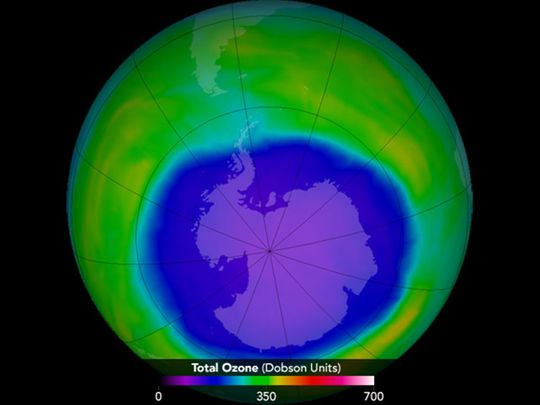
There is a hole in the Earth’s atmosphere that’s larger than the whole of South America.
Click start to play today’s Crossword, which is all about words related to the atmosphere.
The hole, or ozone hole, lies right above Antarctica and covers an area between 21 million square kilometres and 27 million square kilometres. And it’s not the only one. Two of the deepest and largest ozone holes in recent times occurred in 2006 and 2011.
According to a December 2013 report in the National Geographic, these ruptures in the Earth’s atmosphere are concerning, because the ozone layer shields the planet’s surface from the sun’s ultraviolet radiation, which can result in skin cancer and cataracts in people.
However, the massive hole above Antarctica has recently shown signs of healing. Waxing and waning, the hole is expected to vanish entirely by 2070, and be on the road to recovery over the next decade. Scientists, however, are not chalking up this recovery to any new human-made progress on climate change – the shrinkage is likely a sign of variable weather and winds.
One landmark decision by humans, however, made an undeniably massive difference to the Earth’s protective ozone barrier. Over 30 years ago, in 1987, the US and other industrialised countries signed the Montreal Protocol on Substances that Deplete the Ozone Layer. Today, 197 countries follow the Protocol, and the result has been the phasing out of 99 per cent of nearly 100 ozone-depleting chemicals.
Without it, the planet’s ozone layer would have collapsed entirely by 2050, with catastrophic consequences, according to a September 2017 report in the National Geographic. Our global climate today would have been at least 25 per cent hotter without the Montreal Protocol.
For instance, the UV Index in Los Angeles, US, in the middle of summer would have been at least 30 by 2070 – anything over 11 is considered extreme. Hurricanes and cyclones would have increased by three times, there would have been millions more cases of skin cancer and cataracts worldwide, and people would have gotten sunburned in under five minutes!
Do you think the world needs other successful environmental treaties to protect it against global warming? Play today’s Crossword and tell us at games@gulfnews.com.








